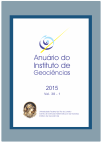Late Holocene Palynological Record in Sediments of the Piraquê-Açu River Estuary, Espírito Santo, Brazil
DOI:
https://doi.org/10.11137/2015_1_107_115Keywords:
Palynological analysis, Fluvial sediments, Late HoloceneAbstract
The Piraquê-Acu river is located at the municipality of Aracruz, 83 km north of Vitória city, Espírito Santo State, Brazil. Palynological analysis was performed based on one core (PA20) collected at coordinates 19°56'13.63"S and 40°10'29.50"W and approximately 110 cm long. The main purpose of this study was to recognise and interpret the vegetation dynamics in the region around the collection site during last 1700 cal. yrs BP for future investigations. The core was sampled at each 10 cm and the samples were submitted to standard palynological processes. One tablet of exotic spore Lycopodium clavatum was added to calculate palynomorph concentration. The material of four levels has been dated obtaining the oldest age of 1758 À 68 cal. yrs BP at an approximately 105 cm depth. The core analysis indicates a strong presence of mangrove vegetation, mainly characterized by the Rhizophora pollen type. The Alluvial Community and the Ombrophilous Forest vegetation were well represented also experiencing minor fluctuations. The increase of this elements in 10 cm depth may be associated with the human activity caused by the arrival of immigrants into the estuary area. The core top presented Eucalyptus pollen type, being related to the started expansion of large scale planting species of this genus in the Espírito Santo State.Downloads
Published
2017-02-15
Issue
Section
Article
License
This journal is licensed under a Creative Commons — Attribution 4.0 International — CC BY 4.0, which permits use, distribution and reproduction in any medium, provided the original work is properly cited.

















